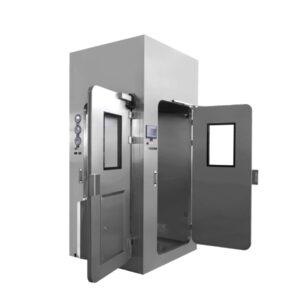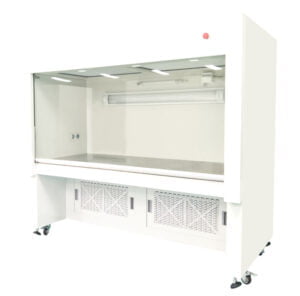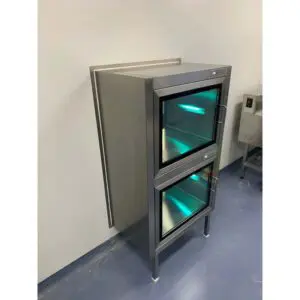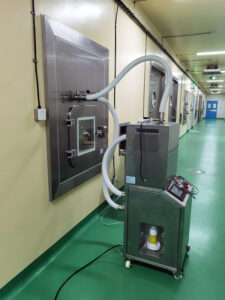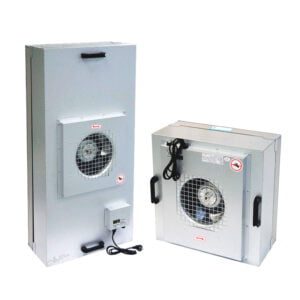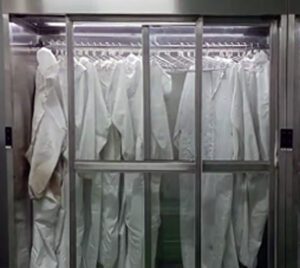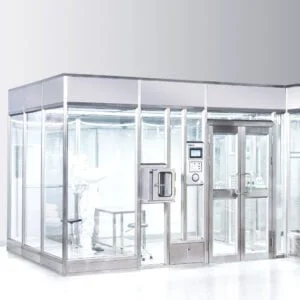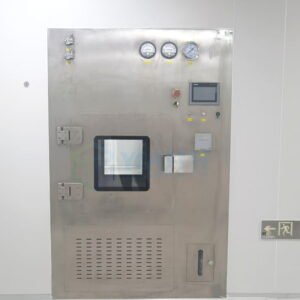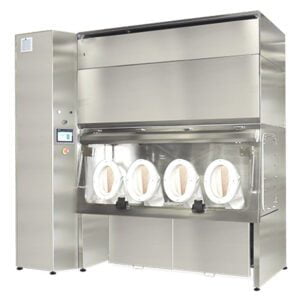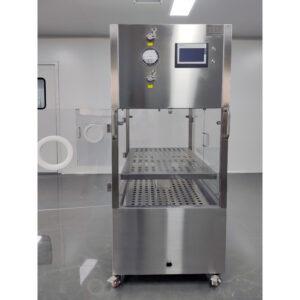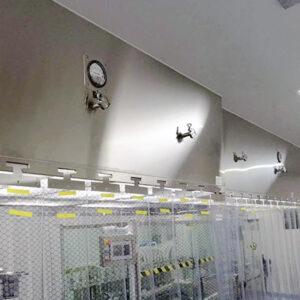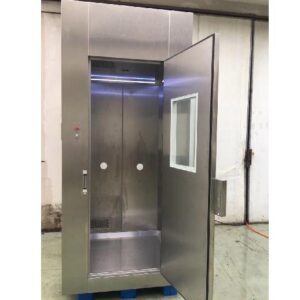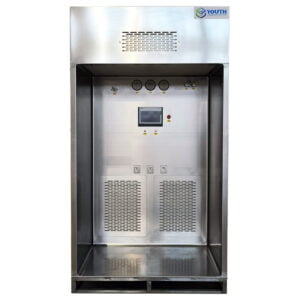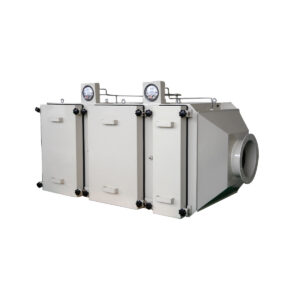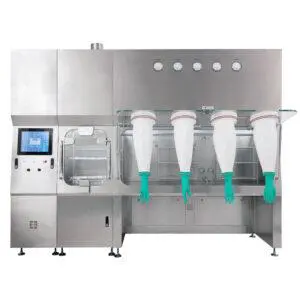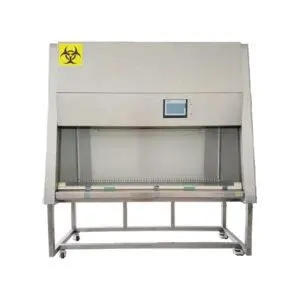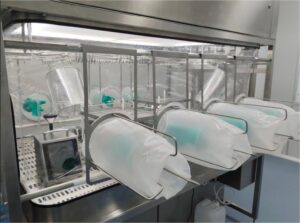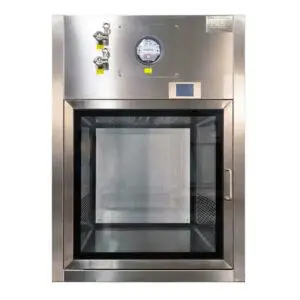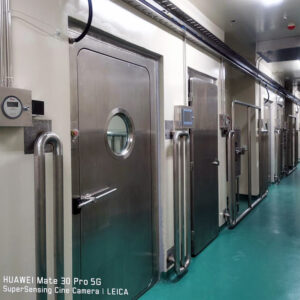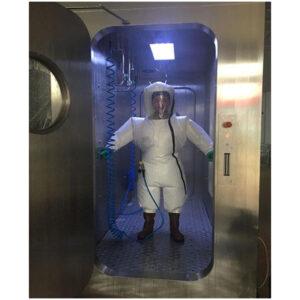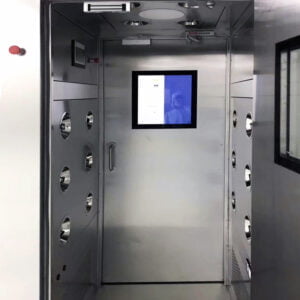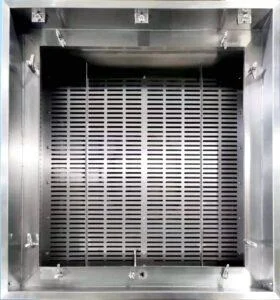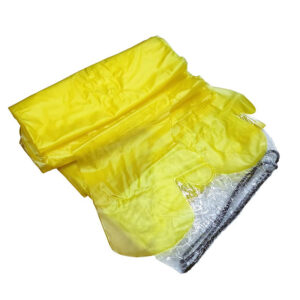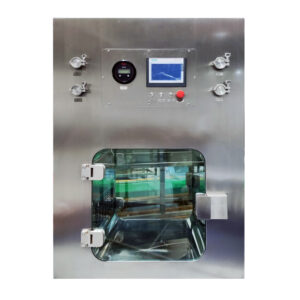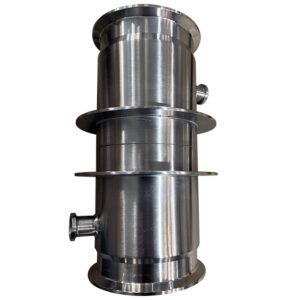In the realm of pharmaceutical manufacturing, maintaining a sterile and controlled environment is paramount. One critical component in achieving this level of control is the implementation of biosafety airtight doors. These specialized doors play a crucial role in preventing contamination, controlling airflow, and ensuring the safety of both personnel and products. As the pharmaceutical industry continues to evolve and face new challenges, the importance of these doors in maintaining biosafety standards cannot be overstated.
The use of biosafety airtight doors in pharmaceutical manufacturing facilities addresses multiple concerns, including containment of hazardous materials, prevention of cross-contamination, and maintenance of precise environmental conditions. These doors are designed with advanced sealing mechanisms, durable materials, and sophisticated control systems to meet the stringent requirements of the industry. From research laboratories to production areas, biosafety airtight doors are essential in creating and maintaining the sterile environments necessary for the development and manufacture of pharmaceuticals.
As we delve deeper into the world of biosafety airtight doors, we'll explore their key features, applications, and the critical role they play in ensuring the integrity of pharmaceutical manufacturing processes. We'll examine the latest technologies and design innovations that make these doors indispensable in modern facilities, as well as the regulatory standards they must meet. By understanding the importance and functionality of biosafety airtight doors, we can better appreciate their contribution to the safety and efficacy of pharmaceutical products.
Biosafety airtight doors are essential components in pharmaceutical manufacturing facilities, providing a critical barrier against contamination and ensuring the maintenance of sterile environments necessary for the production of safe and effective medications.
What are the key features of biosafety airtight doors?
Biosafety airtight doors are engineered with a range of sophisticated features designed to meet the exacting standards of pharmaceutical manufacturing environments. These doors are not merely barriers; they are complex systems that actively contribute to the maintenance of sterile conditions and the prevention of contamination.
One of the most critical features of biosafety airtight doors is their advanced sealing mechanism. This typically involves inflatable sealing strips that create an airtight seal when the door is closed. The sealing pressure is carefully monitored to ensure consistent performance and prevent air leakage. Additionally, these doors often incorporate supply gas pressure monitoring systems to maintain the integrity of the seal.
The materials used in the construction of biosafety airtight doors are chosen for their durability, resistance to chemicals, and ease of cleaning. Stainless steel is a common choice due to its corrosion resistance and ability to withstand frequent sanitization. Some doors may also feature fiberglass-reinforced plastic panels, which offer similar benefits with the added advantage of being lightweight.
Biosafety airtight doors utilize inflatable sealing strips and pressure monitoring systems to create and maintain an impenetrable barrier against air leakage and contamination in pharmaceutical manufacturing environments.
| Feature | Function |
|---|---|
| Inflatable Sealing Strips | Create airtight seal |
| Sealing Pressure Monitoring | Ensure consistent performance |
| Supply Gas Pressure Monitoring | Maintain seal integrity |
| Stainless Steel Construction | Provide durability and chemical resistance |
How do biosafety airtight doors contribute to contamination control?
Contamination control is a critical aspect of pharmaceutical manufacturing, and biosafety airtight doors play a pivotal role in this process. These specialized doors act as a physical barrier between different areas of a facility, preventing the spread of contaminants and maintaining the integrity of clean environments.
The airtight seal created by these doors is essential in controlling airflow between spaces. By preventing air leakage, they help maintain pressure differentials between rooms, which is crucial for directing airflow from cleaner to less clean areas. This unidirectional airflow is a key principle in contamination control strategies within pharmaceutical facilities.
Furthermore, biosafety airtight doors contribute to contamination control by facilitating the implementation of airlocks and buffer zones. These transitional spaces, equipped with airtight doors at both ends, allow for the controlled movement of personnel and materials between areas of different cleanliness classifications without compromising the sterility of critical spaces.
The airtight seal and controlled airflow facilitated by biosafety doors are fundamental to preventing cross-contamination and maintaining the sterility of pharmaceutical manufacturing environments.
| Contamination Control Measure | Impact |
|---|---|
| Airtight Seal | Prevents air leakage between spaces |
| Pressure Differential Maintenance | Directs airflow from clean to less clean areas |
| Airlock Implementation | Enables controlled transitions between zones |
What types of biosafety airtight doors are available for pharmaceutical facilities?
Pharmaceutical facilities have a range of biosafety airtight door options to choose from, each designed to meet specific operational needs and space requirements. The selection of the appropriate door type is crucial for ensuring efficient workflows while maintaining stringent biosafety standards.
Sliding doors are a popular choice in many pharmaceutical manufacturing areas due to their space-saving design and smooth operation. These doors can be either single or double-leaf, depending on the size of the opening required. Hermetically sealing sliding doors, such as those offered by [ (YOUTH)[youthfilter.com] ], feature advanced track systems that ensure a tight seal when closed while allowing for easy movement.
Swing-out doors are another common type, often used in areas where space allows for a wider arc of movement. These doors can be designed with either single or double leaves and are particularly useful in high-traffic areas or where equipment needs to be moved frequently.
For applications requiring the highest level of containment, such as biosafety level 3 or 4 laboratories, specialized airtight doors with additional security features may be employed. These can include interlocking systems that prevent simultaneous opening of doors in airlocks, ensuring the integrity of containment at all times.
The diversity of biosafety airtight door types, including sliding, swing-out, and specialized high-containment models, allows pharmaceutical facilities to tailor their door selection to specific operational requirements and biosafety levels.
| Door Type | Best Application |
|---|---|
| Sliding Doors | Space-constrained areas, high-traffic zones |
| Swing-out Doors | Equipment movement, wide openings |
| High-Containment Doors | BSL-3 and BSL-4 laboratories |
What materials are used in the construction of biosafety airtight doors?
The materials used in the construction of biosafety airtight doors are carefully selected to meet the stringent requirements of pharmaceutical manufacturing environments. These materials must not only provide the necessary sealing properties but also withstand frequent cleaning and disinfection procedures without degradation.
Stainless steel is one of the most widely used materials for biosafety airtight doors due to its excellent corrosion resistance, durability, and ease of cleaning. It can withstand harsh cleaning agents and maintains its integrity over long periods of use. Typically, 304 or 316 grade stainless steel is used, with 316 being preferred in more corrosive environments.
Fiberglass-reinforced plastic (FRP) is another material gaining popularity in the construction of biosafety airtight doors. FRP offers a combination of lightweight properties and high strength, making it suitable for large door panels. It also provides excellent chemical resistance and can be molded into seamless designs that minimize crevices where contaminants could accumulate.
For viewing panels, tempered glass or polycarbonate materials are often used. These materials provide transparency while maintaining the door's structural integrity and airtight properties. In some cases, lead-lined glass may be used in areas where radiation protection is required.
The use of materials such as stainless steel, fiberglass-reinforced plastic, and specialized transparent panels in biosafety airtight doors ensures durability, cleanability, and compliance with pharmaceutical manufacturing standards.
| Material | Key Properties |
|---|---|
| Stainless Steel | Corrosion resistance, durability |
| Fiberglass-Reinforced Plastic | Lightweight, chemical resistance |
| Tempered Glass/Polycarbonate | Transparency, impact resistance |
How are biosafety airtight doors integrated into cleanroom designs?
The integration of biosafety airtight doors into cleanroom designs is a critical aspect of pharmaceutical facility planning. These doors must be seamlessly incorporated to maintain the integrity of controlled environments while allowing for efficient personnel and material flow.
Cleanroom designs typically feature biosafety airtight doors at key transition points between areas of different cleanliness classifications. This includes entries to production areas, airlocks, and material transfer zones. The doors are often integrated with the cleanroom's HVAC system to maintain proper pressure differentials and airflow patterns.
Consideration must be given to the door's operation within the cleanroom context. For instance, sliding doors may be preferred in areas where space is limited or where the air disturbance caused by swinging doors could be problematic. The Biosafety Airtight Door offered by Youth Cleanroom is an example of a system designed for seamless integration into various cleanroom configurations.
Interlocking systems are often incorporated into the design, particularly in airlocks or high-containment areas. These systems ensure that only one door in a series can be opened at a time, maintaining the integrity of the controlled environment. Additionally, the integration may include electronic access control systems to manage and log personnel movement through different cleanroom zones.
The strategic placement and thoughtful integration of biosafety airtight doors in cleanroom designs are essential for maintaining environmental control, facilitating proper workflow, and ensuring compliance with pharmaceutical manufacturing standards.
| Integration Aspect | Purpose |
|---|---|
| Placement at Transition Points | Control movement between cleanliness zones |
| HVAC System Coordination | Maintain pressure differentials and airflow |
| Interlocking Systems | Prevent simultaneous door opening in critical areas |
| Electronic Access Control | Manage and log personnel movement |
What are the regulatory standards for biosafety airtight doors in pharmaceutical manufacturing?
Regulatory standards for biosafety airtight doors in pharmaceutical manufacturing are stringent and multifaceted, reflecting the critical role these components play in maintaining product quality and safety. Compliance with these standards is not optional; it is a fundamental requirement for pharmaceutical facilities worldwide.
In the United States, the Food and Drug Administration (FDA) sets guidelines for pharmaceutical manufacturing facilities, including specifications for cleanroom equipment such as biosafety airtight doors. These guidelines are part of the Current Good Manufacturing Practice (cGMP) regulations, which emphasize the importance of contamination control and environmental monitoring.
Internationally, the International Organization for Standardization (ISO) provides standards that are widely adopted in the pharmaceutical industry. ISO 14644, which covers cleanrooms and associated controlled environments, includes specifications that affect the design and operation of biosafety airtight doors. Specifically, ISO 14644-4 addresses the design, construction, and start-up of cleanrooms, including requirements for doors and airlocks.
The European Union's Good Manufacturing Practice (EU GMP) guidelines also provide detailed requirements for cleanroom design and operation, including specifications for doors in different grades of cleanrooms. These guidelines emphasize the need for smooth, impervious surfaces that are easy to clean and resistant to cleaning and disinfecting agents.
Biosafety airtight doors must comply with a range of regulatory standards, including FDA cGMP regulations, ISO 14644 standards, and EU GMP guidelines, to ensure they meet the exacting requirements of pharmaceutical manufacturing environments.
| Regulatory Body | Relevant Standard |
|---|---|
| FDA | cGMP Regulations |
| ISO | ISO 14644 Series |
| EU | EU GMP Guidelines |
How do biosafety airtight doors impact energy efficiency in pharmaceutical facilities?
Biosafety airtight doors play a significant role in the energy efficiency of pharmaceutical facilities. While their primary function is to maintain sterile environments and prevent contamination, they also contribute to the overall energy management of the facility.
The airtight seals of these doors help maintain pressure differentials between different areas of the facility. By preventing air leakage, they reduce the load on HVAC systems, which would otherwise need to work harder to maintain the required pressure and temperature conditions. This translates to lower energy consumption and reduced operational costs.
However, the frequent opening and closing of these doors in high-traffic areas can lead to energy losses. To mitigate this, many modern biosafety airtight doors incorporate rapid opening and closing mechanisms, minimizing the time the door remains open. Some advanced systems also include sensors that trigger the door to open only when approached, further reducing unnecessary air exchanges.
The materials used in biosafety airtight doors can also contribute to energy efficiency. Insulated door panels help maintain temperature differentials between spaces, reducing the thermal load on HVAC systems. Additionally, some doors may incorporate energy-efficient lighting or windows that allow natural light to penetrate, potentially reducing artificial lighting needs in certain areas.
While primarily designed for containment, biosafety airtight doors contribute significantly to energy efficiency in pharmaceutical facilities by maintaining pressure differentials, reducing HVAC load, and incorporating energy-saving features.
| Energy Efficiency Feature | Benefit |
|---|---|
| Airtight Seals | Reduce HVAC load |
| Rapid Opening/Closing Mechanisms | Minimize air exchanges |
| Insulated Panels | Maintain temperature differentials |
| Sensor-Triggered Operation | Prevent unnecessary openings |
What maintenance is required for biosafety airtight doors?
Proper maintenance of biosafety airtight doors is crucial to ensure their continuous performance and longevity in pharmaceutical manufacturing environments. Regular maintenance not only preserves the doors' functionality but also helps maintain compliance with regulatory standards and prevents costly downtime.
A comprehensive maintenance program for biosafety airtight doors typically includes regular inspections of the sealing mechanisms. This involves checking the integrity of inflatable seals, ensuring proper inflation pressure, and inspecting for any signs of wear or damage. The door's frame and panels should also be examined for any structural issues or potential breach points.
Cleaning and sanitization are integral parts of maintenance for these doors. Given their use in sterile environments, they must be cleaned according to strict protocols using compatible cleaning agents. This process should be documented as part of the facility's quality assurance program.
The mechanical components of the door, such as hinges, tracks, and motorized systems (if present), require regular lubrication and adjustment to ensure smooth operation. For doors with electronic components, such as interlocking systems or access controls, routine testing and calibration are necessary to maintain their reliability.
Regular maintenance of biosafety airtight doors, including seal inspections, cleaning, mechanical servicing, and electronic system checks, is essential for ensuring their continued effectiveness in maintaining sterile environments in pharmaceutical manufacturing facilities.
| Maintenance Task | Frequency |
|---|---|
| Seal Inspection | Monthly |
| Cleaning and Sanitization | Daily or as per protocol |
| Mechanical Servicing | Quarterly |
| Electronic System Check | Bi-annually |
In conclusion, biosafety airtight doors are indispensable components in the pharmaceutical manufacturing industry, playing a crucial role in maintaining sterile environments and ensuring product safety. These specialized doors, with their advanced sealing mechanisms and robust construction, provide an effective barrier against contamination while facilitating the controlled movement of personnel and materials.
The importance of biosafety airtight doors extends beyond their primary containment function. They contribute significantly to energy efficiency, help maintain pressure differentials, and support compliance with stringent regulatory standards. The variety of door types available, from sliding to swing-out models, allows pharmaceutical facilities to tailor their selection to specific operational needs and space constraints.
As the pharmaceutical industry continues to evolve, with increasing emphasis on contamination control and energy efficiency, the role of biosafety airtight doors is likely to become even more critical. Ongoing advancements in materials, sealing technologies, and integration with facility management systems will further enhance their effectiveness and efficiency.
Ultimately, the successful implementation and maintenance of biosafety airtight doors are essential for pharmaceutical manufacturers to ensure product quality, protect personnel, and meet regulatory requirements. By understanding the features, applications, and maintenance needs of these doors, facilities can optimize their use and contribute to the overall safety and efficiency of pharmaceutical manufacturing processes.
External Resources
Hermetic vs Hygienic Doors for Sterile Cleanrooms – Terra Universal – Compares hermetic and hygienic doors for cleanroom applications, discussing their features and suitability for pharmaceutical manufacturing.
Biosafety Airtight Door – Youth Cleanroom – Provides detailed information on biosafety airtight doors, including their working principle and key features for high-containment environments.
Doors for Hospitals, Research Labs and Pharmaceutical Facilities – Terra Universal – Offers an overview of various types of cleanroom doors suitable for pharmaceutical facilities, including hermetically-sealed models.
BioSafe® Cleanroom Doors – Terra Universal – Focuses on Terra's BioSafe® doors designed for the life science industry, highlighting their features and compliance with industry standards.
Cleanroom Doors – Esco Lifesciences – Provides information on cleanroom doors designed for pharmaceutical and bio-pharmaceutical facilities, emphasizing compliance with international standards.
Hermetic Sealing Sliding Doors – Dortek – Describes Dortek's hermetic sealing sliding doors, designed for environments where hygiene and air leakage control are critical.
- Pneumatic Seal APR Doors – Youth Cleanroom – Explains the functionality of Pneumatic Seal APR Doors, including their pneumatic sealing mechanism and pressure differential resistance.
Related Contents:
- Biosafety Airtight Doors: Essential Components for Contamination Control
- The Importance of Biosafety Airtight Doors in Maintaining Laboratory Standards
- Biosafety Airtight Doors: Elevating Laboratory Safety Standards
- Biosafety Airtight Doors: Guardians of Containment Facilities
- Biosafety Airtight Doors: Enhancing Laboratory Safety and Containment
- Biosafety Airtight Doors: Mastering Air Pressure Control
- Customizing Biosafety Airtight Doors for Optimal Protection
- Choosing the Perfect Biosafety Airtight Door for Your Facility
- Advancing Safety: Innovations in Biosafety Airtight Door Technology


